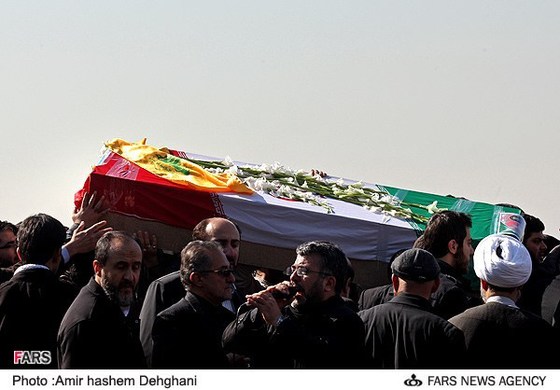On Feb. 13, press reports stated that General Hassan Shateri had been killed in Syria. The circumstances and exact date of Shateri's death are not entirely clear, however.
Iran's embassy in Beirut said that Shateri, a senior commander in Iran's Revolutionary Guards Corps, had been killed by "armed terrorists" while traveling from Damascus to Beirut. Iran's Fars News Agency said that Shateri had been killed by the "Zionist regime's henchmen." The Syrian Observatory for Human Rights claimed that Syrian rebels were responsible for Shateri's death.
Meanwhile, a spokesman for the Free Syrian Army claimed that Shateri did not die on Feb. 12, as many reports had suggested. According to the spokesman, Shateri had been killed in Israel's strike on a weapons convoy near the SSRC facility in Jamraya in late January.
Shateri is "the highest-ranking Iranian official killed in Syria's uprising" to date, according to the Wall Street Journal. Shateri's importance is further seen by the fact that his family was notified of his "martyrdom" by the head of Iran's Quds Force, Major General Qassem Soleimani, according to Abna News Agency. As Iranian-Israeli analyst Meir Javedanfar noted, Soleimani "does not confirm the death of any ordinary IRGC person."
Photos from Shateri's funeral in Tehran on Feb. 14 show Soleimani sobbing as well as IRGC head Mohammad Ali Jafari and Iran's Foreign Minister Ali Akbar Salehi. Shateri's ties to Hezbollah were also apparent during the funeral, as at one point a Hezbollah flag was seen on top of his coffin.
In addition, Shateri was compared to former Hezbollah commander Imad Mughniyah, who was killed in February 2008 in Damascus. Influential cleric Hojatoleslam Panahiyan said: "Shateri was no less than Mughniyah. He had a special place, in the way that he will be missed and his purity. That's all that can be said as his secret contributions cannot be mentioned." Mourners at Iran's embassy in Beirut on Feb. 14 included a number of Hezbollah officials.
Background on Hassan Shateri
Hassan Shateri, a.k.a. Hessam Khoshnevis, who was added in 2010 to the US's list of global terrorists along with three other IRGC leaders "for their roles in the IRGC-QF's support of terrorism," was a senior commander in the IRGC as well as the director of the Iranian Committee for the Reconstruction of Lebanon (ICRL).
According to the Treasury Department designation, Shateri provided "technical support to Hezbollah's reconstruction efforts in Lebanon and to the expansion of the terrorist group's private communications network." In addition, he was "President Ahmadinejad's personal representative in Lebanon."
A recent report in Asharq Al-Awsat gives more details on Shateri's activities in Lebanon. According to the report, Shateri was sent to Lebanon in 2006 and "controlled several funds amounting to $200 million a year used to replace Hezbollah's lost arsenal and rebuild its missile sites close to the demarcation line with Israel." Additionally, he "sat on Hezbollah's Central Command and helped shape the party's policies with advice from Secretary-General Hassan Nasrallah." More importantly, Shateri helped with "the creation of an 'inner-state' in Lebanon."
In Lebanon, Shateri also reportedly had a thriving real estate company in addition to a "business empire" that included "banks, shopping malls, hotels, transport companies, radio and television networks, newspapers, and travel agencies."
The Iranian Committee for the Reconstruction of Lebanon (ICRL), which Shateri headed, was also designated in 2010 by Treasury. According to Treasury, the ICRL "was established by the Government of Iran after the 2006 Israel-Hezbollah conflict and functions as a key channel for Iran's support to Hezbollah reconstruction efforts in Lebanon." In addition, it "financed and facilitated Hezbollah's infrastructure and private communications network that enables the terrorist group to communicate securely."
